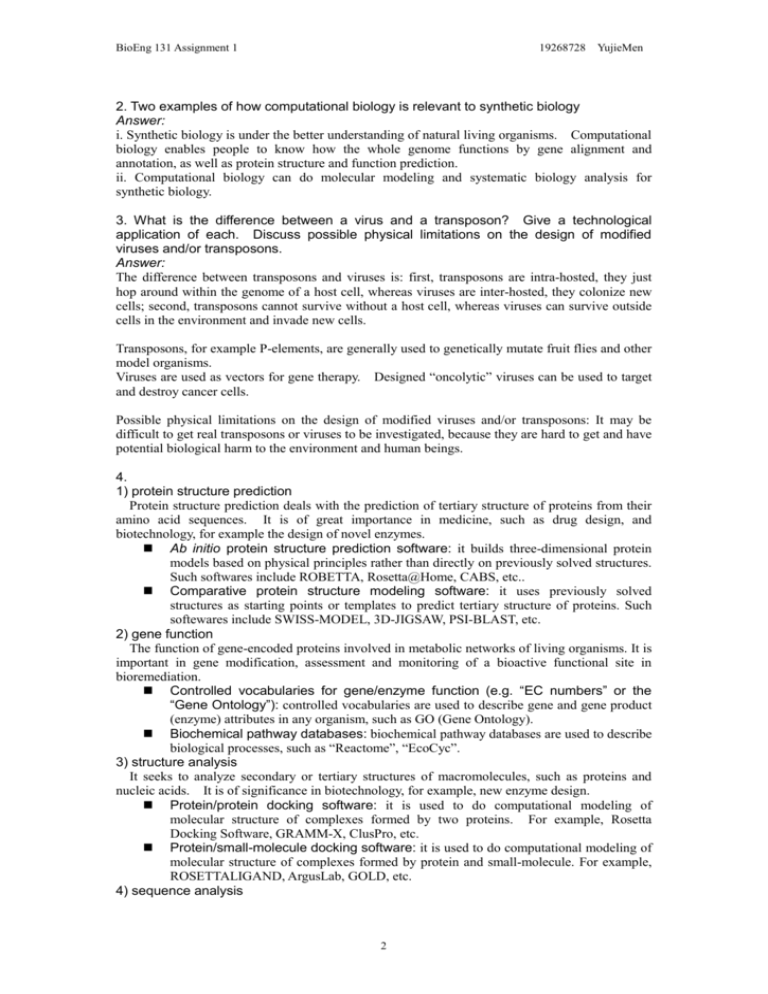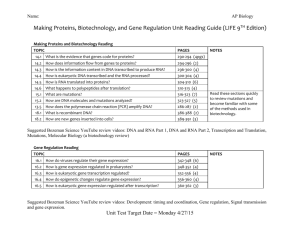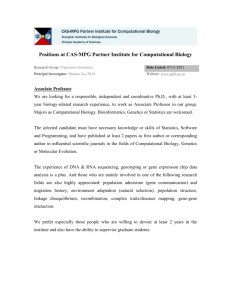assignment1
advertisement

BioEng 131 Assignment 1 19268728 YujieMen 2. Two examples of how computational biology is relevant to synthetic biology Answer: i. Synthetic biology is under the better understanding of natural living organisms. Computational biology enables people to know how the whole genome functions by gene alignment and annotation, as well as protein structure and function prediction. ii. Computational biology can do molecular modeling and systematic biology analysis for synthetic biology. 3. What is the difference between a virus and a transposon? Give a technological application of each. Discuss possible physical limitations on the design of modified viruses and/or transposons. Answer: The difference between transposons and viruses is: first, transposons are intra-hosted, they just hop around within the genome of a host cell, whereas viruses are inter-hosted, they colonize new cells; second, transposons cannot survive without a host cell, whereas viruses can survive outside cells in the environment and invade new cells. Transposons, for example P-elements, are generally used to genetically mutate fruit flies and other model organisms. Viruses are used as vectors for gene therapy. Designed “oncolytic” viruses can be used to target and destroy cancer cells. Possible physical limitations on the design of modified viruses and/or transposons: It may be difficult to get real transposons or viruses to be investigated, because they are hard to get and have potential biological harm to the environment and human beings. 4. 1) protein structure prediction Protein structure prediction deals with the prediction of tertiary structure of proteins from their amino acid sequences. It is of great importance in medicine, such as drug design, and biotechnology, for example the design of novel enzymes. Ab initio protein structure prediction software: it builds three-dimensional protein models based on physical principles rather than directly on previously solved structures. Such softwares include ROBETTA, Rosetta@Home, CABS, etc.. Comparative protein structure modeling software: it uses previously solved structures as starting points or templates to predict tertiary structure of proteins. Such softewares include SWISS-MODEL, 3D-JIGSAW, PSI-BLAST, etc. 2) gene function The function of gene-encoded proteins involved in metabolic networks of living organisms. It is important in gene modification, assessment and monitoring of a bioactive functional site in bioremediation. Controlled vocabularies for gene/enzyme function (e.g. “EC numbers” or the “Gene Ontology”): controlled vocabularies are used to describe gene and gene product (enzyme) attributes in any organism, such as GO (Gene Ontology). Biochemical pathway databases: biochemical pathway databases are used to describe biological processes, such as “Reactome”, “EcoCyc”. 3) structure analysis It seeks to analyze secondary or tertiary structures of macromolecules, such as proteins and nucleic acids. It is of significance in biotechnology, for example, new enzyme design. Protein/protein docking software: it is used to do computational modeling of molecular structure of complexes formed by two proteins. For example, Rosetta Docking Software, GRAMM-X, ClusPro, etc. Protein/small-molecule docking software: it is used to do computational modeling of molecular structure of complexes formed by protein and small-molecule. For example, ROSETTALIGAND, ArgusLab, GOLD, etc. 4) sequence analysis 2 BioEng 131 Assignment 1 19268728 YujieMen It deals with the determination of sequences of nucleic acids or proteins and comparison of different sequences between genomes, genes or proteins. It is widely used in phylogenetic evolution, classification, as well as new gene design. Sequence assembly software: aligning and merging fragments of a much longer DNA sequence in order to reconstruct the original sequence. Assemblers include AMOS, CAP3, Euler, etc. Gene-finding software: is used to find a certain gene by using GeneName, GeneID or relevant information. It is based on gene sequence database. Finding tools include EMBL, NCBI, DDBJ, etc. 5) RNA structure The functional form of RNA usually has a specific tertiary structure. The RNA structure can be used in virus design. RNA folding software: it is used to predict RNA structure. For example, CONTRAfold, Mfold, RNAfold, etc. RNA design software: it can be used not only to predict a RNA structure, but also to design a RNA sequence given particular structural or functional properties. For example, RNAsoft. 2








